Wat is WebP?
WebP is een modern formaat voor het sneller dan ooit serveren van afbeeldingen. Als u WordPress gebruikt, kunt u gemakkelijk alle afbeeldingen in WebP serveren met enkele eenvoudige aanpassingen.
Leren over
De meeste browsers ondersteunen WebP
- Volgens de gegevens van Caniuse wordt WebP momenteel ondersteund in 94% browsers, waaronder Apple Safari, Google Chrome, Opera, Mozilla Firefox, Microsoft Edge en Android-browsers.
- U kunt nog steeds JPEG/PNG serveren als fallback voor niet-ondersteunde browsers.
Grote voordelen van het gebruik van WebP formaat Image
- In vergelijking met de grootte van een normale JPG- of PNG-afbeelding, kan dezelfde dimensie van WebP in kleine bytes worden gebruikt. Afbeeldingen worden dus sneller geladen. Dit is vooral nuttig voor mobiele gebruikers.
- Serveren van kwaliteitsbeelden in weinig bytes, drastisch besparen van bandbreedte.
- Houd uw website bijgewerkt met de nieuwste trend. Verlies geen gesprek als gevolg van bull-cart langzaam laden probleem.
- WebP wordt aanbevolen door Google Developers. Helpt u bij het passeren van “afbeeldingen in next-gen formaat” aanbeveling van Google PageSpeed Insight.
Zo kun je WebP serveren voor een WordPress site.
WebP Express Plugin gebruiken in NGINX
- Installeer en activeer WebP Express, gratis plugin. Een grote dank aan Dev.
- Werkingsmodus: Gevarieerde beeldreacties.
- Toepassingsgebied: Alleen uploaden.

- Ren Bulk Convert

- Voor Apache gebruikers is geen configuratie nodig, want .htaccess doet alle magie.
- NGINX server gebruiker moet configuratie bestand aanpassen met root toegang.
Voor een betere organisatie van de code zou ik aanraden om deze eerst in de /etc/nginx/ directory te plaatsen met de naam webp.conf en dan op te nemen in het hoofdblok van de server.
Voer onderstaand commando in
cd /etc/nginx/ && nano webp.conf- Plak onderstaande code met rechtsklik in nano editor in SSH Terminal.
# WebP Express rules
# --------------------
location ~* ^/?wp-content/.*\.(png|jpe?g)$ {
add_header Vary Accept;
expires 365d;
if ($http_accept !~* "webp"){
break;
}
try_files
/wp-content/webp-express/webp-images/doc-root/$uri.webp
$uri.webp
/wp-content/plugins/webp-express/wod/webp-on-demand.php?xsource=x$request_filename&wp-content=wp-content
;
}
# Route requests for non-existing webps to the converter
location ~* ^/?wp-content/.*\.(png|jpe?g)\.webp$ {
try_files
$uri
/wp-content/plugins/webp-express/wod/webp-realizer.php?wp-content=wp-content
;
}
# ------------------- (WebP Express rules ends here)
- Druk op CTRL+O en Enter om op te slaan.
Ga nu naar het hoofdserverblok.
cd /etc/nginx/sites-available && lsZeer aan te bevelen: Leer WordPress installeren bij NGINX (In drie eenvoudige stappen)
Bewerk uw configuratiebestand, en zet include webp.conf; zoals hieronder getoond.
# General
server {
listen 80;
server_tokens off;
return 301 https://$host$request_uri;
}
server {
server_tokens off;
root /var/www/html;
index index.php index.html index.htm;
server_name .gulshankumar.net;
client_max_body_size 0;
listen [::]:443 ssl http2 ipv6only=on;
listen 443 ssl http2;
ssl_protocols TLSv1.1 TLSv1.2 TLSv1.3;
ssl_certificate /etc/comodo/cert.pem;
ssl_certificate_key /etc/comodo/private.pem;
ssl_prefer_server_ciphers on;
ssl_session_cache shared:SSL:20m;
ssl_session_timeout 20m;
ssl_ciphers 'TLS13+AESGCM+AES128:EECDH+AES128';
error_page 404 /404.html;
error_page 500 502 503 504 /50x.html;
# WebP Express rule goes here
include webp.conf;
# WebP Rule end
location / {
try_files $uri $uri/ /index.php$is_args$args;
}
Herlaad of herstart NGINX.
service nginx reloadDingen om op te merken
- Als je BunnyCDN gebruikt, moet je Vary Cache inschakelen.
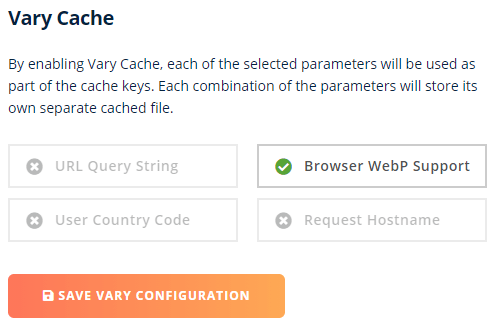
- Cloudflare ondersteunt geen Vary Cache. Probeer onderstaande alternatieve aanpak.
WebP gebruiken met Cloudflare CDN (zonder plugin)
Als u een Cloudflare Pro-gebruiker bent, kunt u WebP met één klik inschakelen vanuit het tabblad Snelheid.
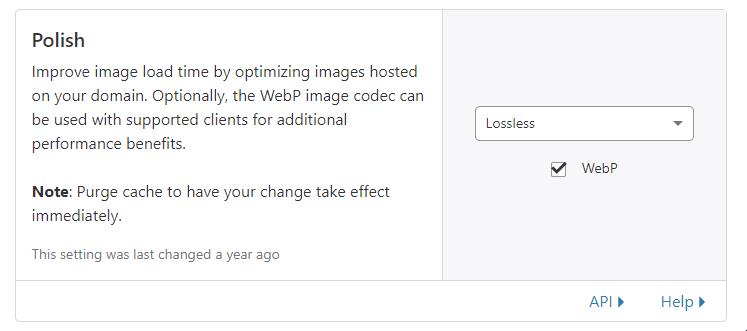
WebP serveren met BunnyCDN Optimizer (zonder plugin)
BunnyCDN biedt Optimizer diensten die wordt geleverd met On-the-fly WebP serving oplossing. Het is een one-click oplossing voor $9.5/mo extra kosten.
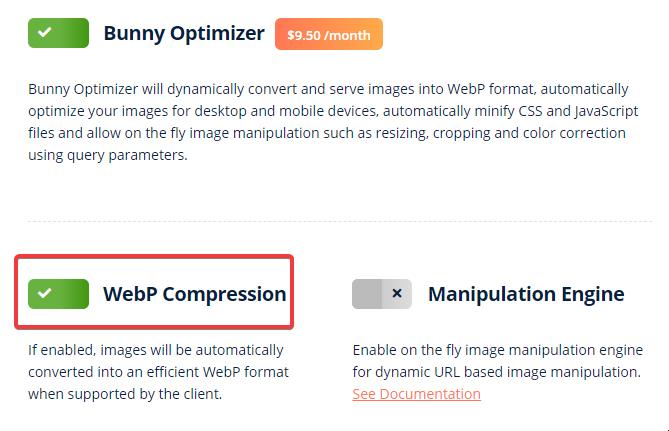
Webp met JetPack-plugin serveren
- Gewoon JetPack plugin installeren en activeren
- Schakel de Site Accelerator in.

U kunt een vermindering van de beeldkwaliteit opmerken die kan worden verholpen met het onderstaande filter.
add_filter('jetpack_photon_pre_args', 'jetpackme_custom_photon_compression' );
function jetpackme_custom_photon_compression( $args ) {
$args['quality'] = 100;
$args['strip'] = 'all';
return $args;
}WebP serveren in NGINX met behulp van ShortPixel Plugin
ShortPixel plugin kan helpen in bulk beeldoptimalisatie met WebP conversie en dienen als per Browser ondersteuning. Het beste deel deze plugin doet verwerking op hun server dus het zal niet vertragen uw site.
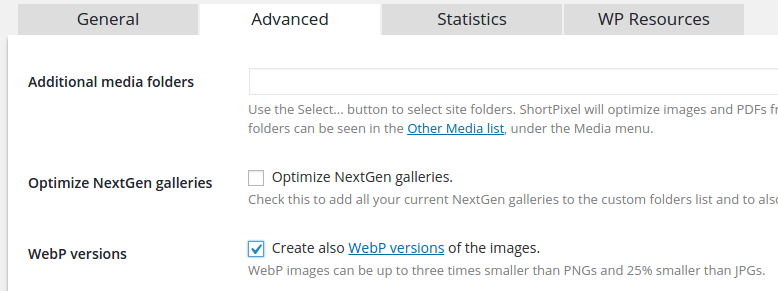
- Als je Apache webserver gebruiker bent kun je .htaccess herschrijven. Dat is eenvoudig.
- In geval van NGINX u kunt onderstaande herschrijvingsregel gebruiken met de hulp van hosting support
- Deze plugin wordt ook ondersteund met WP Rocket cache plugin.
Voeg eerst dit blok toe vóór de serverrichtlijn:
map $http_accept $webp_suffix {
default "";
"~*webp" ".webp";
}Voeg dit blok toe in de serverrichtlijn:
location ~* ^(/wp-content/.+)\.(png|jpe?g)$ {
set $base $1;
set $webp_uri $base$webp_suffix;
set $webp_old_uri $base.$2$webp_suffix;
set $root "<<FULL PATH OF wp-content PARENT>>";
root $root;
add_header Vary Accept;
if ( !-f $root$webp_uri ) {
add_header X_WebP_SP_Miss $root$webp_uri;
}
try_files $webp_uri $webp_old_uri $uri =404;
}Plaatsing is belangrijk. Dus voeg het voorzichtig toe.
WebP weergeven met Imagify
Imagify is een plugin voor het optimaliseren van afbeeldingen, aangeboden door WP Media, de mensen achter WP Rocket.
- Installeer en activeer de Imagify-plugin
- Voer de API-sleutel in
- Kies in instellingen de modus Beeldmerken voor een snelle instelling.
- Als alternatief kunt u rewrite rule gebruiken met wat serverconfiguratie zoals hier beschreven. Met Apache zal de .htaccess code toevoeging automatisch gebeuren, maar met NGINX moet je dat handmatig doen.
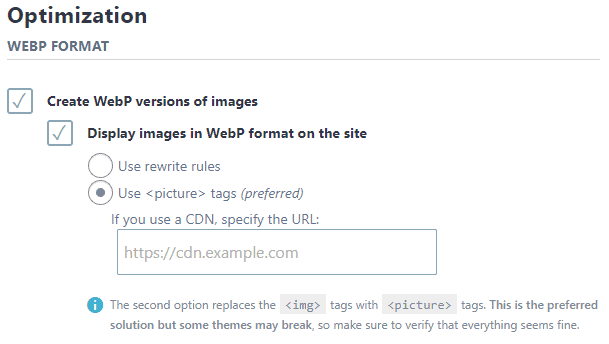
WebP naar JPG
WebP kan in sommige gevallen de beeldkwaliteit wat verminderen. Als u terug wilt van WebP naar JPG, volg dan deze stappen.
- WebP gerelateerde plugin deactiveren & verwijderen.
- Verwijder de gerelateerde instellingen uit het configuratiebestand (.htaccess)
- Bulk verwijdert .webp bestanden en bespaart schijfruimte.
find . -type f -name "*.webp*" -deleteAls u WebP-bestand wilt converteren naar JPG, kunt u het gereedschap gebruiken dat beschikbaar is op CloudConvert.
Handmatige methode zonder plugin
Dit gedeelte is alleen ter informatie.
Stap 1: WebP formaat toevoegen in HTML document
Eerst moet u uw alle beelden in WebP en samen met uw vorige beeldformaat als fall-back converteren. Er is een plugin zoals Optimus die dit automatisch kan doen. Maar ik zal een andere eenvoudige manier tonen om dit handmatig te doen.
- Ga naar deze website image.online-convert.com/convert-to-webp
- Plak uw afbeeldingslink en klik op converteren. Uw WebP-formaat afbeeldingen worden gedownload
- Bewerk nu de ruwe HTML-code waar uw normale afbeelding staat.
Stel, in het begin was uw HTML-code voor afbeeldingen als volgt
<img src="https://www.gulshankumar.net/wp-content/uploads/2016/09/webplogo.png" alt="gulshan kumar" width="186" height="66" />U moet bovenstaande code omwikkelen met wat meer HTML-opmaak.
<picture>
<source srcset="https://www.gulshankumar.net/wp-content/uploads/2016/09/webplogo.webp" type="image/webp" />
<img src="https://www.gulshankumar.net/wp-content/uploads/2016/09/webplogo.png" alt="gulshan kumar" width="186" height="66" />
</picture>Nu is uw HTML-document klaar om afbeeldingen in WebP-formaat weer te geven.
Stap 2: serverinstellingen configureren
Nog één stap, u moet enkele Apache Webserver instellingen configureren via .htacccess zodat browser en webserver het correct kunnen behandelen zoals alle andere afbeeldingen.
Uw Web Hosting server kan niet weten van welk mime type dit soort formaat afbeeldingen ze moeten dienen. Dus moet u het juiste mime type toevoegen. Ook zou het de moeite waard zijn om een vervaldatum header in te stellen voor caching.
# Serve Images with correct Mime Type
AddType image/webp .webp
# Setup Cache
ExpiresActive On
ExpiresByType image/webp A2592000Let op: Zorg ervoor dat je WordPress 5.8 of later gebruikt.
Als u WordPress gebruikt die ouder is dan versie 5.8 ondersteunt het uploaden van WebP afbeeldingen niet. U kunt de foutmelding “Dit bestandstype is om veiligheidsredenen helaas niet toegestaan” krijgen bij het uploaden van .webp-afbeeldingen.
Dus, moet dit probleem oplossen door deze code toe te voegen in uw thema functions.php Het zou nuttig zijn in het geval als u uw afbeeldingen rechtstreeks uploadt van WordPress Dashboard > Media option.
function webp_upload_mimes( $existing_mimes ) {
// add webp to the list of mime types
$existing_mimes['webp'] = 'image/webp';
// return the array back to the function with our added mime type
return $existing_mimes;
}
add_filter( 'mime_types', 'webp_upload_mimes' );Klaar.
Als je hulp nodig hebt, kijk dan op commentaar sectie of word lid van mijn forum. Het zou mij een genoegen zijn u te helpen.
Aanvullende opmerkingen
- Als u een Cloudways gebruiker bent, kunt u WebP niet leveren met .htaccess rewrite omdat zij NGINX specifiek gebruiken voor statische bestanden. In dit geval heeft u twee keuzes. Vraag het hostingteam om het configuratiebestand voor u aan te passen of gebruik JavaScript of een CDN-gebaseerde oplossing van derden zoals Bunny of CF.
Verdere lectuur
Als u meer wilt weten over WebP, raadpleeg dan deze links.
Bedankt.
I didn’t try the webp format as of now in WordPress. But now after reading this post I will try to implement it. I will compare the image quality from other formats as well. Thank you for sharing this article.
Have you experienced the WebP format causing problems for seo? is it better to use it as jpg or this way?
Google officially recommends using WebP format images along with JPG as fallback.
How to remove hyperlink for the webp image format?
I guess you want to remove .webp extension from URL. You need to try rewrite approach.
I have a question about ShortPixel method.
I use Plesk panel with NGINX
There is a section called Additional nginx directives
Here you can specify the settings for the nginx reverse proxy server that runs in front of Apache. Your directives will override the server-wide nginx configuration. For example, you may want to change the connection timeout or to pack requests with gzip. Use the same syntax as you use for nginx.conf. For example, if you want to pack all the proxied requests with gzip, add the line: ‘gzip_proxied any;’.
https://i.imgur.com/OLWu9bJ.png
can i add codes there i dont know?
map $http_accept $webp_suffix {
default “”;
“~*webp” “.webp”;
}
location ~* ^(/wp-content/.+).(png|jpe?g)$ {
set $base $1;
set $webp_uri $base$webp_suffix;
set $webp_old_uri $base.$2$webp_suffix;
set $root “<>”;
root $root;
add_header Vary Accept;
if ( !-f $root$webp_uri ) {
add_header X_WebP_SP_Miss $root$webp_uri;
}
try_files $webp_uri $webp_old_uri $uri =404;
You used these sentences!
before the server directive and inside directive.
I read your Installing WordPress at NGINX topic so
If i try to add these from codes is this right?
map $http_accept $webp_suffix {
default “”;
“~*webp” “.webp”;
}
server {
listen 80;
return 301 https://$host$request_uri;
}
server {
location ~* ^(/wp-content/.+).(png|jpe?g)$ {
set $base $1;
set $webp_uri $base$webp_suffix;
set $webp_old_uri $base.$2$webp_suffix;
set $root “<>”;
root $root;
add_header Vary Accept;
if ( !-f $root$webp_uri ) {
add_header X_WebP_SP_Miss $root$webp_uri;
}
try_files $webp_uri $webp_old_uri $uri =404;
}
# Document Root
root /var/www/html;
index index.php index.html index.htm;
server_name .example.com;
client_max_body_size 0;
listen [::]:443 ssl http2 ipv6only=on;
listen 443 ssl http2;
ssl_protocols TLSv1.1 TLSv1.2 TLSv1.3;
ssl_certificate /etc/letsencrypt/live/example.com/fullchain.pem;
ssl_certificate_key /etc/letsencrypt/live/example.com/privkey.pem;
ssl_prefer_server_ciphers on;
ssl_session_cache shared:SSL:20m;
ssl_session_timeout 20m;
ssl_ciphers ‘TLS13+AESGCM+AES128:EECDH+AES128′;
error_page 404 /404.html;
error_page 500 502 503 504 /50x.html;
location / {
try_files $uri $uri/ /index.php$is_args$args;
}
location ~* .php$ {
if ($uri !~ “^/uploads/”) {
fastcgi_pass unix:/run/php/php7.4-fpm.sock;
}
include fastcgi_params;
fastcgi_param SCRIPT_FILENAME $document_root$fastcgi_script_name;
fastcgi_param SCRIPT_NAME $fastcgi_script_name;
}
location = /favicon.ico {
log_not_found off;
access_log off;
}
location = /robots.txt {
log_not_found off;
access_log off;
allow all;
}
location ~* .(css|gif|svg|ico|jpeg|jpg|js|png)$ {
expires 1y;
log_not_found off;
}
# Enable Gzip compression.
gzip on;
# Disable Gzip on IE6.
gzip_disable “msie6”;
# Allow proxies to cache both compressed and regular version of file.
# Avoids clients that don’t support Gzip outputting gibberish.
gzip_vary on;
# Compress data, even when the client connects through a proxy.
gzip_proxied any;
# The level of compression to apply to files. A higher compression level increases
# CPU usage. Level 5 is a happy medium resulting in roughly 75% compression.
gzip_comp_level 5;
# Compress the following MIME types.
gzip_types
application/atom+xml
application/javascript
application/json
application/ld+json
application/manifest+json
application/rss+xml
application/vnd.geo+json
application/vnd.ms-fontobject
application/x-font-ttf
application/x-web-app-manifest+json
application/xhtml+xml
application/xml
font/opentype
image/bmp
image/svg+xml
image/x-icon
text/cache-manifest
text/css
text/plain
text/vcard
text/vnd.rim.location.xloc
text/vtt
text/x-component
text/x-cross-domain-policy;
}
Is this right?
And what do you think about plesk how i use webp at plesk?
Thanks
Please consult a freelancer. It is out of scope to guide here.
Hi, this is a good article, but
It is better to install the plugin or put the code directly for webp
This way, each image does not create two urls. Does it cause a problem in the SEO site?
Dynamic rewriting from Server side doesn’t create two URLs instead it servers same just by changing response as per browser support.
A plugin is recommended way.
Hi Gulshan. Any free plugin(totally free) for converting jpg to webp format. God Bless you.
First option which is WebP Express.
Thank You! Gulshan
Hey Gulshan Kumar ,
Awesome post with good information. It is my first time commenting on your blog post and am glad to say that you have done a fabulous work and provided helpful & easy tips to serve webp format images in WordPress. I really like and appreciate the way you have explained the things in such a step-by-step process making the concept very clear and easy to understand. while scrolling through your blog post i have noticed that you have also discussed about the major benefits of using webp format image that are also providing good understanding. You have explained all the vital things in an easy language that are true enough to understand and educate the readers.
After going through this complete guide i really gain ideas and am sure that this post is definitely going to help lots of people & especially WordPress-users to sort out their query. Good work and keep sharing more similar post.
Eventually thanks for sharing your knowledge, ideas and such an informative post.
Regards
-Aadarsh
Hi Adarsh, Thanks for your kind words. It really means a lot to me.
Hello. Please check Hiwebp plugin wordpress.
https://wordpress.org/plugins/hiwebp/
Works a treat, thanks!
If you disable copy function then it’s better to not include any code reference. okay?
Thanks for notifying. I have allowed copying function for snippet in this article.
I have tried this method to enable WebP format images on my site, but I am encountering some unknown error. My site showing a low score on google page speed insight.
May I know please which specific method you have tried? Also, please share the screenshot of error. I will try my best to help you.
Why is not wordpress supporting WEBP format by default?Its high time now.
It works great in Chrome and Firefox on the PC/Laptop. BUT, the webp images are not displayed on iPhone (Chrome and Safari)
Safari is not supporting webP. Chrome on iOS is based on Safari, too. So webP won‘t work on iOS at all and you have to serve a fallback image.
Works a treat, thanks!
Hi,
I am not quite clear on where this needs to be inserted. I am looking to Optimise my header image to Webp. Is there a video or screenshot based write up on how I can include this?
Would really appreciate the help
Regards
Shwetha
Hello Gulshan,
Thanks for sharing this article.
I did follow the steps mentioned in here in this format.
But the image is not appearing on Firfox, and IE. Did I miss any thing in here.
Please suggest.
This code no longer works. He’s not loading. I don’t know why it doesn’t work.
It should work fine. Please share your site URL so I can check.
Hi..Just wondering if i need to edit each image tag or is there somewhere in my theme templates this could be done.
Any guidence would be great.
Thanks
Mark
Do I need to edit all the image tags one by one now? Isn’t there another way to do that?
Hi Gulshan,
Even after putting the code snippet in the function.php file.
I still have the same error message when I try to upload webp format. The message is “sorry this file type is not permitted for security reasons”.
Can you help fix this?
Thanks.
Martin
Hello Martin,
At my end it’s working fine. For a demo, I have sent a quick video on your email. Please check and revert back if I can help with any thing else.
Thanks
I haven’t added anything except the last code from your post in function.php to support Webp format on all of future media uploads. Do I need to add any thing else ? or will it create any kind of issue for users whose browsers are yet unsupported to this format?
anyway keep up the good work 😉
That’s all. Now you can easily upload webp directly in your WordPress Dashboard. No extra things to do. Just feel free to use it with picture HTML tag. So, it will support for all browsers, without any issues. Thanks
The problem with the suggested HTML implementation is that Chrome will make two requests, one for WEBP and another one for JPEG resulting in double requests and increasing the page load time.
Hey dear,
It doesn’t create two requests(as you are saying) instead it automatically serve only one type image format either WebP or JPEG according to HTTP accept type.
I’d suggest please try one more time and look carefully at Network Timeline in the browser console. If you see there are double requests, please email me your HTML code and timeline screenshot also. I’d love to review it. I believe it should work fine for you too.
Thanks & Regards,
Gulshan
I installed the code into the functions.php. And as you said it did allow me to upload in my WP theme. The problem is that the image doesn’t allow cropping so it won’t allow me to use it on the site.